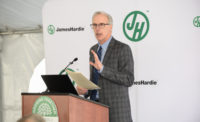HDR’s design expertise has been recruited to help tackle the affordable housing crisis in California.
The Los Angeles County Development Authority selected Contour Crafting Corporation, in collaboration with HDR and the supportive services provider Volunteers of America, to design and build 3D printed modular homes in the county.
The county’s open competition solicited proposals for a demonstration project to study several different delivery methods for permanent housing for the homeless faster and more cost effectively than with traditional construction.
The proposed design comprises four 3D printed housing units, each with small private patios to further expand the living area, all clustered around a shared courtyard. CC Corps’ customizable 3D printer allows each unit’s exterior to be unique in form and color, while maintaining the efficiency and modularity of the interior elements like the kitchen and bathroom layouts. Leveraging the insulated thermal mass of the 3D printed building envelope, the proposed design also delivers high levels of human comfort. This is demonstrated through lower energy consumption, such that the overall project can achieve net-zero energy with only a limited number of photovoltaic roof panels.
Another benefit of using 3D technology on this project rests in the curved design. Curvature does not add to construction costs and actually strengthens the performance of the concrete printed shell. It also maximizes efficiency by aligning the printing of pairs of units in the north/south orientation, such that the printer rails only need to be moved once. This tactic will shorten the construction delivery time. Given the flexibility inherent in 3D printing, this concept is highly scalable and could be adapted to meet several housing or community needs.
“In Los Angeles County, far, far too many people find themselves homeless,” said Kate Diamond, HDR’s civic design director. “It really doesn’t matter whether they were simply priced out of their homes by gentrification or they are veterans coping with PTSD. For those coping with homelessness, living on the streets threatens their very survival. Our innovative approach of fast, cost-effective and deeply sustainable 3D printed housing is a way to help serve the most vulnerable populations.”
“This project is taking on a critical societal challenge – how to deliver housing smarter, cheaper and faster to combat homelessness through innovative engineering solutions” added Vartan Chilingaryan, director of structural engineering at HDR.
Through the incorporation of sustainable design strategies, the proposed design targets LEED Gold and is likely to achieve LEED Platinum.


